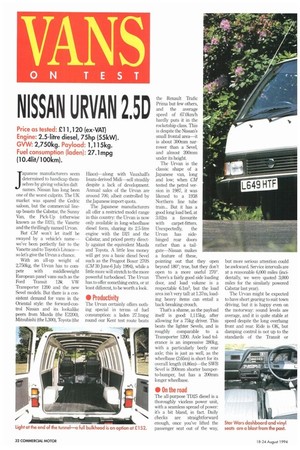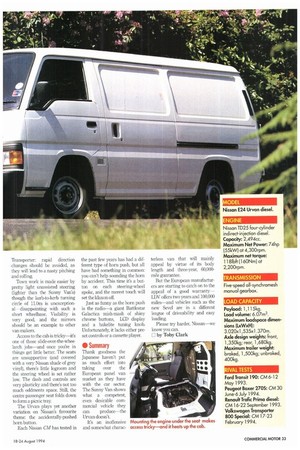NISSAN URVAN 2.5D
Page 34

Page 35

If you've noticed an error in this article please click here to report it so we can fix it.
Price as tested: £11,120 (ex-VAT) Engine: 2.5-litre diesel, 75hp (55kW). GVW: 2,750kg. Payload: 1,1 15k9. Fuel consumption (laden): 27.1mpg (10.4Iit/ 100km) • Japanese manufacturers seem determined to handicap themselves by giving vehicles daft names. Nissan has long been one of the worst cailprits. The UK market was spared the Cedric saloon, but the commercial lineup boasts the Cabstar, the Sunny Van, the Pick-Up (otherwise known as the D21), the Vanette and the thrillingly named Urvan.
But CM won't let itself be swayed by a vehicle's name— we've been perfectly fair to the Vanette and to Toyota's liteaceso let's give the Urvan a chance.
With an all-up weight of 2,750kg, the Urvan has to com pete with middleweight European panel vans such as the Ford Transit 12Q, VW Transporter 1200 and the new Sevel models. But there is a consistent demand for vans in the Oriental style: the forward-control Nissan and its lookalike peers from Mazda (the E2200), Mitsubishi (the L300), Toyota (the Hiace)—along with Vauxhall's lsuzu-derived Midi—sell steadily despite a lack of development. Annual sales of the Urvan are around 700, albeit controlled by the Japanese import quota.
The Japanese manufacturers all offer a restricted model range in this country-. the Urvan is now only available in long-wheelbase diesel form, sharing its 2.5-litre engine with the D21 and the Cabstar, and priced pretty directly against the equivalent Mazda and Toyota. A little less money will get you a basic diesel Sevel such as the Peugeot Boxer 270S (CM 30 June-6 July 1994), while a little more will stretch to the more powerful turbodiesel. The Urvan has to offer something extra, or at least different, to be worth a look.
• Productivity
The Urvan certainly offers nothing special in terms of fuel consumption: a laden 27.1mpg round our Kent test route beats the Renault Trafic Prima but few others, and the average speed of 67.0km/h hardly puts it in the rocketship class. This is despite the Nissan's small frontal area—it is about 300mm narrower than a Sevel, and almost 200mm under its height.
The Urvan is the classic shape of a Japanese ran, long and low; when CM tested the petrol version in 1987, it was likened to a 1938 Northern line tube train... But it has a good long load bed, at 3.02m a favourite with carpet-fitters. Unexpectedly, the Urvan has sidehinged rear doors rather than a tailgate—Nissan makes a feature of these, pointing out that they open beyond 180°; true, but they don't open to a more useful 2700. There's a fairly good side loading door, and load volume is a respectable 6.1m3, but the load area isn't very tall: at 1.37m, loading heavy items can entail a back-breaking crouch.
That's a shame, as the payload itself is good: 1,115kg, after allowing for a 75kg driver. This beats the lighter Sevels, and is roughly comparable to a Transporter 1200. Axle load tolerance is an impressive 280kg, with a particularly beefy rear axle; this is just as well, as the wheelbase (2.65m) is short for its overall length (4.86m)—the SWB Sevel is 200mm shorter bumperto-bumper, but has a 200mm longer wheelbase.
• On the road
The all-purpose TD25 diesel is a thoroughly viceless power unit, with a seamless spread of power: it's a bit bland, in fact. Daily checks are straightforward enough, once you've lifted the passenger seat out of the way, but more serious attention could be awkward. Service intervals are at a reasonable 6,000 miles (incidentally, we were quoted 3,000 miles for the similarly powered Cabstar last year).
The Urvan might be expected to have short gearing to suit town driving, but it is happy even on the motorway: sound levels are average, and it is quite stable at speed despite the long overhang front and rear. Ride is OK, but damping control is not up to the standards of the Transit or Transporter: rapid direction changes should be avoided, as they will lead to a nasty pitching and rolling.
Town work is made easier by pretty light unassisted steering (lighter than the Sunny Van's) though the kerb-to-kerb turning circle of 11.0m is unexceptional disappointing with such a short wheelbase. Visibility is very good, and the mirrors should be an example to other van makers.
Access to the cab is tricky—it's one of those slide-over-the-wheelarch jobs—and once you're in things get little better. The seats are unsupportive (and covered with a very Nissan shade of grey vinyl), there's little legroom and the steering wheel is set rather low. The dash and controls are very plasticity and there's not too much oddments space. Still, the centre passenger seat folds down to form a picnic tray.
The Limn plays yet another variation on Nissan's favourite theme: the accidentally-pushed horn button.
Each Nissan CM has tested in
the past few years has had a different type of horn push, but all have had something in common: you can't help sounding the horn by accident. This time it's a button on each steering-wheel spoke, and the merest touch will set the klaxon off.
Just as funny as the horn push is the radio—a giant Battlestar Galactica mish-mash of shiny chrome buttons, LCD display and a bakelite tuning knob. Unfortunately, it lacks either preset controls or a cassette player.
• Summary Thank goodness the Japanese haven't put as much effort into taking over the European panel van market as they have with the car sector. The Sunny Van shows what a competent, even desirable commercial vehicle they can produce the Urvan doesn't.
It's an inoffensive and somewhat charac terless van that will mainly appeal by virtue of its body length and three-year, 60,000mile guarantee.
But the European manufacturers are starting to catch on to the appeal of a good warrantyLDV offers two years and 100,000 miles—and vehicles such as the new Sevel are in a different league of driveability and easy loading.
Please try harder, Nissan—we know you can.
El by Toby Clark
























































































